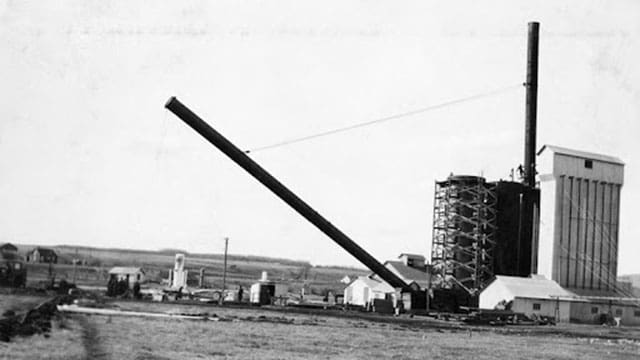Royalite No. 4 was the well that put Turner Valley, and Alberta, on the map

For interview requests, click here
This is the story of Royalite No. 4, better known as the “Wonder Well,” and its pivotal role in shaping Canada’s energy history. It’s a tale of frontier ingenuity, engineering breakthroughs, and a key moment in the development of Alberta’s petroleum industry.
Royalite No. 4’s discovery not only transformed the Turner Valley field but also marked a major shift in the future of energy extraction in the province, laying the groundwork for modern energy practices.
On Oct. 14, 1924, at 5 p.m., Royalite No. 4 “blew in” near Turner Valley, located south of Calgary. Although it’s often referred to as an oil discovery, it was, in fact, a significant natural gas find, enriched with valuable condensates. These condensates, part of what is known as the C1-C6 value chain, represent a range of hydrocarbons classified by the number of carbon atoms they contain – from methane (C1) to hexane (C6). The discovery was a major breakthrough for the industry, revealing that the Turner Valley Formation had far more to offer than the expected dry gas.
At a depth of 3,740 feet, the well unleashed a powerful mix of gas and condensates, demonstrating that Turner Valley held much greater potential. These condensates weren’t crude oil, as many assumed, but lighter hydrocarbons that added immense value to the find.
Crude oil would be discovered later in the field, most notably with Turner Valley Royalties No. 1 in 1936, but it was Royalite No. 4’s natural gas discovery that truly changed the game for the industry.
Since the discovery of the nearby Dingman No. 1 well in 1914, Alberta’s petroleum sector had been growing rapidly, but Royalite No. 4 accelerated that growth significantly. The well was drilled by the Northwest Company, a subsidiary of Imperial Oil, which was itself part of the Standard Oil empire which, at the time, was one of the largest oil companies in the world. This era was marked by growing concerns about foreign control over Canadian resources, as American expertise from Texas and Oklahoma flowed into Alberta’s nascent energy industry, contributing to its early developments.
The discovery of Royalite No. 4 attracted global attention. Winston Churchill, during a cross-Canada tour in the late 1920s, visited the site, curious about the drilling techniques used and eager to learn how he might invest in the burgeoning sector. Churchill’s interest was more than just financial; he was deeply involved in efforts to modernize the British Royal Navy by converting its fleet from coal to petroleum after the First World War. Securing stable oil supplies was a crucial part of his strategy, making Alberta’s discoveries of particular interest to him.
Royalite No. 4’s legacy extends well beyond the gas and condensates it produced. It played a foundational role in developing the natural gas processing, petroleum refining, and transportation pipelines that became crucial components of Alberta’s energy economy. While the well wasn’t drilled with today’s modern techniques, it was a marvel for its time, using cable tool technology. This method involved lifting and dropping a sharpened tool to slowly chip away at the rock layers. The process was labour-intensive and slow, but it provided valuable geological insights that were applied to future drilling projects.
The drilling process itself was a lesson in early resource extraction. Drillers had to learn how to manage downhole pressure, control temperatures, and handle sour gas containing harmful hydrogen sulfide. These lessons were essential for the sector’s continued growth and laid the groundwork for more advanced techniques in the years that followed.
Drilling at the Royalite No. 4 site began in September 1922 on land owned by the Canadian Pacific Railway, which had been granted mineral rights in exchange for building the national rail system. Since the drilling took place on privately owned land, the record-keeping wasn’t as stringent as it would have been on Crown land. However, the well’s success helped establish the regulatory frameworks that would emerge when Alberta gained control of its natural resources in 1930, following the Natural Resources Transfer Agreement.
One of the pivotal moments in Royalite No. 4’s history came with the decision to keep drilling. Tronson Draper, head of the Northwest Company, made the call to push forward even when there was uncertainty about the well’s potential. His decision paid off. On Oct. 14, 1924, at 3,740 feet, the well blew in with a powerful gusher of gas and condensates, producing an astonishing 21 million cubic feet of gas per day. The blowout was so intense that some compared the sound to a gunshot, and the force of the eruption flung the drill string up the wellbore.
Controlling the gas flow proved to be a major challenge. After several weeks, the gas stream accidentally ignited, creating a massive flare that illuminated the night skies of southern Alberta. The flare became known as “Hell’s Half Acre,” named after a nearby ravine where the flames were eventually redirected. It took weeks of effort to tame the fire, and the expertise of specialists from Oklahoma was called in to manage the situation. The event underscored the dangers and challenges of early oil and gas exploration.
Over its decade of production, Royalite No. 4 produced more than one million barrels of condensates and gasoline. By 1925, the well was supplying one-third of all gasoline consumed in Alberta, a remarkable achievement that paved the way for further drilling in Alberta’s carbonate reservoirs. Although Royalite No. 4 was abandoned in 1934, its contributions to Alberta’s energy industry are undeniable.
Today, only a small sign near Highway 22 in Turner Valley marks the location of the Wonder Well. The tools used to drill the well remain buried in the oil beneath the site, a lasting symbol of the well’s importance to Alberta’s energy history.
Royalite No. 4 not only contributed to the province’s wealth but also provided valuable lessons that shaped the future of energy extraction in the region. Its story continues to be a testament to the ingenuity, tenacity, and ambition of those who pioneered Canada’s early petroleum industry.
Bill Whitelaw is a director and advisor to many industry boards, including the Canadian Society for Evolving Energy, which he chairs. He speaks and comments frequently on the subjects of social licence, innovation and technology, and energy supply networks.
Explore more on Alberta’s Business, Energy sector, Canadian history
The opinions expressed by our columnists and contributors are theirs alone and do not inherently or expressly reflect the views of our publication.
Troy Media
Troy Media is an editorial content provider to media outlets and its own hosted community news outlets across Canada.


